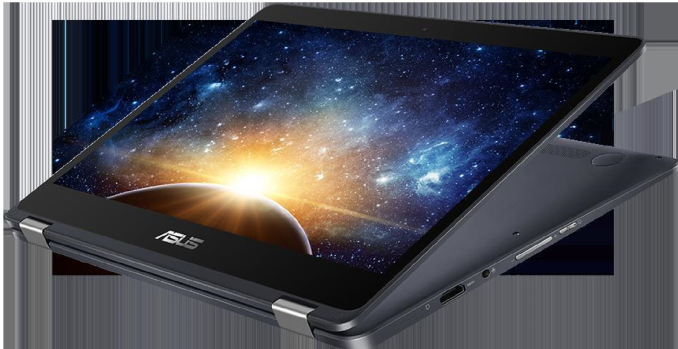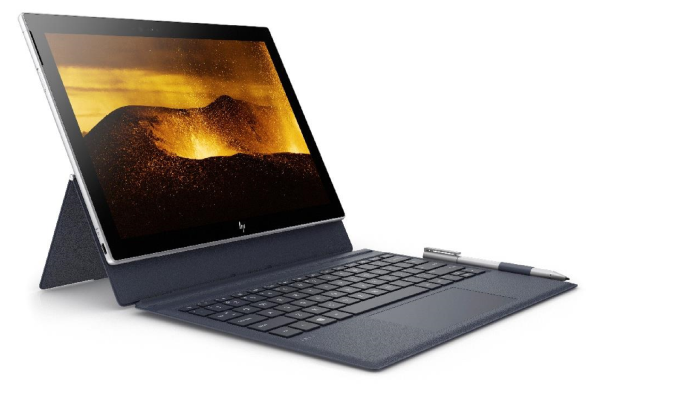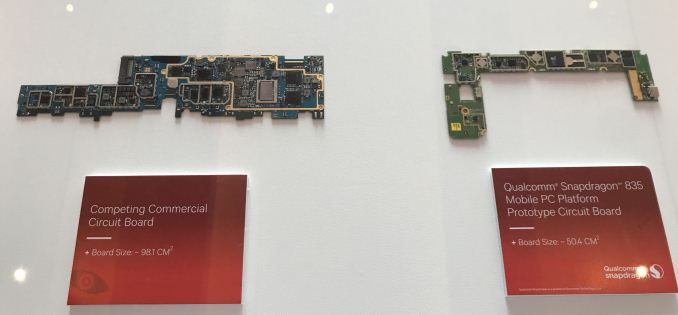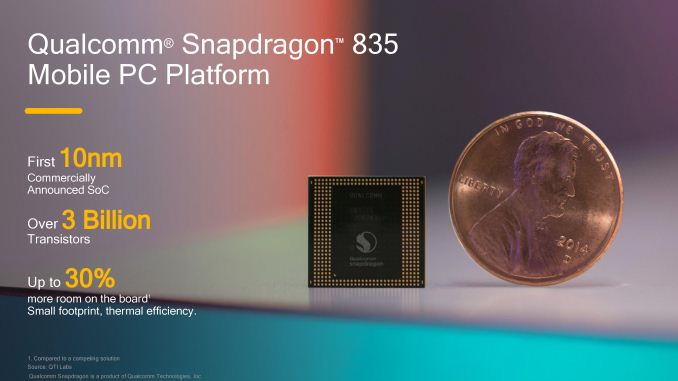Microsoft Launches Windows 10 On ARM: Always Connected PCs
by Brett Howse on December 5, 2017 2:30 PM EST
This morning at the Qualcomm Snapdragon Summit in Hawaii, Microsoft’s EVP of Windows and Devices, Terry Myerson, is announcing the introduction of the first Windows 10 PCs to be powered by Qualcomm Snapdragon processors. It was almost a year ago to the day that the company first announced their partnership with Qualcomm, which would bring ARM support to Windows 10, but with x86 emulation, allowing all existing applications to work as well. The first PCs will be the ASUS NovaGo, which is a convertible laptop, and the HP ENVY x2 convertible tablet.
This is exciting news on a couple of fronts. The Qualcomm Snapdragon 835, which was the processor first announced for Windows 10 on ARM, offers reasonable performance, but with lower power consumption than what we’ve been used to in the PC space, and especially in low-power states. Without having the devices in-hand, we still don’t know how the SD835 compares in performance to the competition. We should finally be able to answer that soon though.
One of the key pieces of using a mobile SoC in a PC is the extra integration. Smartphones don’t have room for large circuit boards, while still providing room for all of the other equipment and batteries required, and mobile SoCs offer a lot more features integrated into the SoC than what a typical PC would, which allows for substantial board space savings over the competition. Back at Computex, Qualcomm was showing off the SD835 PC board compared to a competing 14nm Intel board, and the space savings were up to 30%. This allows smaller, thinner, and lighter devices, but with more battery capacity.
One of the major integrations with the SD835 compared to PC SoCs is the integrated cellular connectivity, which is one of the features that Microsoft is championing the most with this new partnership. There have been PCs with cellular cards added on for some time, but Qualcomm’s cellular tech is aimed at mobile, where always-on connectivity, and low-power usage, is a requirement. That same connectivity will be available on the PC as well, with an always-connected network connection providing a better user experience than what we’ve become accustomed to in the laptop world.
Battery life should also be a big win, and while we don’t have our own tests done yet, Microsoft’s information is claiming up to 30 days of standby and up to 22 hours of active use, while the detachable tablet-style HP ENVY x2 is claiming up to 20 hours of active use. That’s impressive, and blows past the all-day battery life that we’ve come to expect in a laptop, and should free a device up for a couple of days of use before charging. Terry Myerson has stated that he’s been getting up to a week of use out of a device before he needs to charge it.
The always-on nature of mobile brings other advantages too. The PCs will wake up instantly, just like you’d expect on your phone, or mobile tablet.
The ARM equipped devices will be running full Windows 10, so no desktop apps are left behind, unlike the previous time that Microsoft attempted this. The ARM chips at the time offered much less performance as well, so this time around, it should be a much better experience. Universal Windows Apps will be available compiled for ARM directly, but x86 apps will run in emulation, which is still a cause for concern for both performance and battery life, so we’ll have to see how that pans out. Microsoft has an “optimized” version of Office 365 for the new ARM powered PCs, which likely means it’s been recompiled for native performance.
Perhaps the most exciting part of the announcement is what added competition in this space should bring to the end-user. We have Qualcomm coming to the PC from the mobile space, where low-power has always been key, but the performance has been improving steadily, and we have Intel and AMD on the other side, coming from a high-performance but higher-power world, where integration of components into the SoC hasn’t been as high of a priority. It’ll be interesting to see where the convergence happens in the coming months.
Source: Microsoft














59 Comments
View All Comments
ikjadoon - Tuesday, December 5, 2017 - link
EDIT: I said "everything", but IIRC, 64-bit apps will not run.Manch - Wednesday, December 6, 2017 - link
Yup, I don't see the point of the novago when I can get an XPS13 for the same price. 13hrs vs 22 but so what, it lasts a whole work day. Connectivity? Yup I have a cell phone I can tether like everyone else.HStewart - Tuesday, December 5, 2017 - link
Compared to which x86 process - probably Atom CPU in performance and i3/i5/i7 in die board size.I am typing this on Intel Compute Stick which is about a size of deck of cards - this m3-6530 based and not atom.
I think for such device - they should have totally skip x86 application emulation which is likely to be extremely flakily - 32 bit only with limited application support.
HStewart - Tuesday, December 5, 2017 - link
Very deceptive image of board - impossible to tell what x86 platform they are comparing it too.ikjadoon - Tuesday, December 5, 2017 - link
Motherboard sizes have barely shrunk on Intel's now three 14nm platforms. Surely you have seen the inside of an Ultrabook before?...No thin-and-light, sans the MacBook Air's PCB, has reached that tiny amount of board space. I think the MacBook Air's PCB would seem pretty large even now to the SD835 board.
ikjadoon - Tuesday, December 5, 2017 - link
"Totally skip x86 application emulation" = you mean Windows RT? No way--never again.>likely to be extremely flakily - 32 bit only with limited application support.
32-bit isn't a huge loss for *software*; they can still run 8GB of RAM. They've priced these laptops accordingly, IMO.
HStewart - Tuesday, December 5, 2017 - link
At $599 and $799 you can buy a real notebookhttps://www.digitaltrends.com/computing/asus-novag...
ikjadoon - Tuesday, December 5, 2017 - link
Not one with 22 hours of battery life that runs full x86 programs and doesn't look like a brick from 2005, ;)Gunbuster - Tuesday, December 5, 2017 - link
So it's probably not faster than Atom in windows, but at the same time it seems positioned on "premium" devices. Maybe the rational is if you pay $600 for a crap device instead of $300 you'll convince yourself to not be disappointed?HStewart - Tuesday, December 5, 2017 - link
Realistically this device should be pretty well on .net applications - but x86 should be dog slow - but that is probably what Microsoft wants to do all the time - make everything .net in the long run - but realistically with today's applications that is impossible.